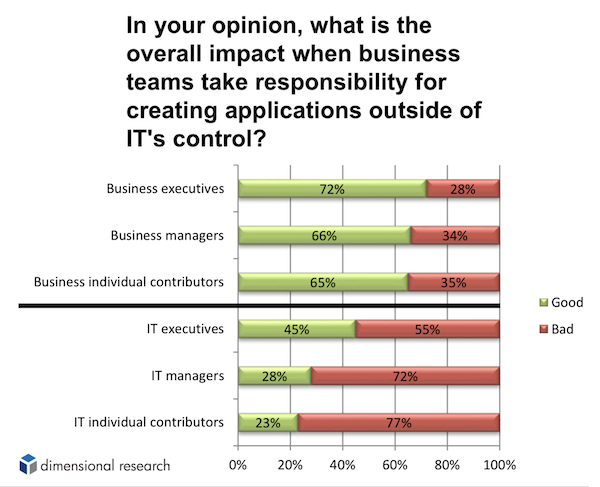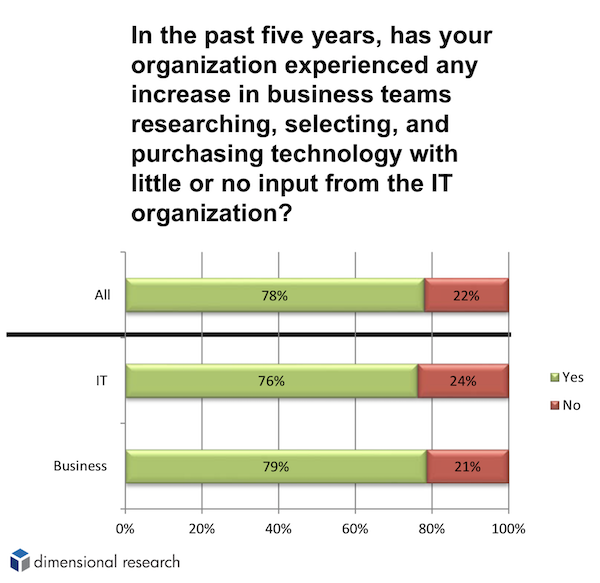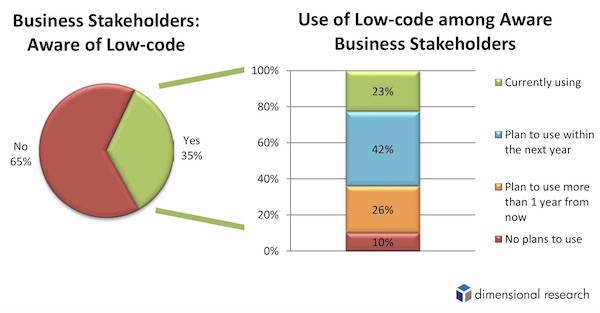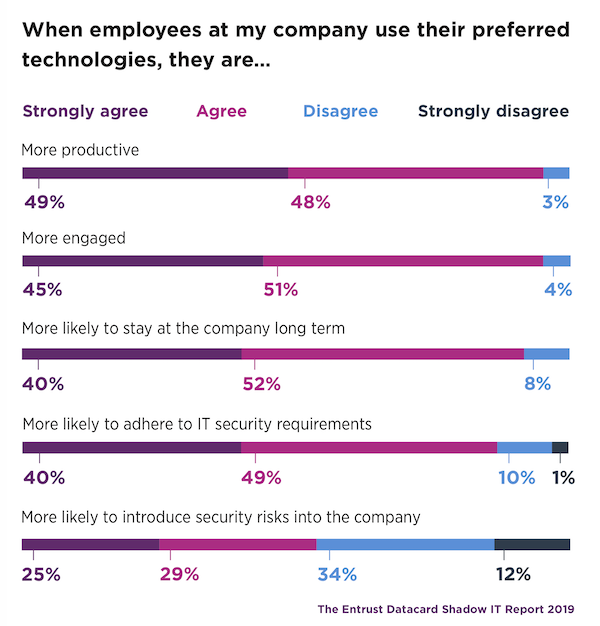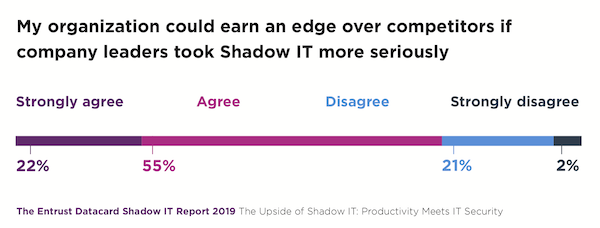There are notable inflection points in the history of martech where you simply have to pause and say, “Wow, the world sure has changed.” Crossing more than 1,000 solutions on the marketing technology landscape in 2014 was one. Digital ad spend surpassing traditional ad spend earlier this year was another.
And now here’s a big one: “shadow IT” is going from bad to good — even in the eyes of IT.
Shadow IT is coming out of the shadows and into the light.
Two recent reports corroborate this shift. Digital Disconnect: A Study of Business and IT Alignment in 2019, a study of over 1,000 IT and business stakeholders by Dimensional Research. And The Upside of Shadow IT, a study of over 1,000 IT professionals by Entrust Datacard.
The graph at the top of this post is from Dimensional Research’s report.
It’s remarkable that 72% of business executives think that building software apps outside of IT’s control is a good thing. That’s a pretty broad embrace of “citizen development” among the leaders of non-IT “citizens.” It’s a testament that business leaders believe the ability for teams outside of IT to shape their own technological destiny is crucial for their success.
But it’s even more remarkable that 45% of IT executives agree.
Okay, so it’s not all roses. 55% of IT executives still think shadow IT is bad. And over 70% of IT managers and staff below them agree. Understandably, the closer it is to their day-to-day work, the more uneasy they may be about “non-experts” wandering into their domain.
But IT leadership increasingly sees the opportunity to reframe their organization from gated bottleneck to governing enabler.
It’s quite possible this is the “acceptance” stage of coming to grips with the changes of living in a digital world. 78% of this study’s participants reported that shadow IT — defined as business teams researching, selecting, and purchasing technology with little or no input from the IT organization — has been increasing over the past five years.
Once you realize you can’t stop the river, you start to think about how to harness its kinetic energy and keep it from flooding uncontrollably.
IT rightfully remains concerned about support and security issues arising from shadow IT. But the answer is moving beyond simply forbidding the sun to rise to putting in place approved frameworks — such as low-code and no-code platforms — that enable citizen developers in business functions to build their own apps within a controlled and monitored environment.
92% of IT executives agree that value can be created — 38% believe significant value — by providing a framework that allows business users to build their own solutions that follow corporate management, governance, and security policies.
This solution is gaining popularity with business executives. More than a third (35%) are now aware of low-code platforms. And out of those who are aware, two thirds (65%) are already using them or plan to within the next year.
Nota bene: That’s a lot of “code” awareness among business executives.
Not so out of the realm of reason to imagine how every marketer can be an app developer.
The report from Entrust Datacard is more conservative about how much control IT should reliquish. (The study was conducted solely among IT professionals and written for that audience, so keep that in mind.)
Hey, there’s certainly room for debate over how light or heavy IT governance of decentralized technology should be in a given organization. Although I strongly believe that an experienced marketing technology and operations team — rooted in the marketing department — can exercise distributed leadership here in partnership with IT.
Yet even this more conservative report acknowledges the incredible benefits of shadow IT:
Okay, that last one isn’t a benefit — although it’s interesting that nearly half (46%) of the IT professionals who responded disagreed that employees using their preferred technologies was more likely to introduce security risks into the company. In fact, 89% agree that employees are more likely to adhere to IT security requirements under those conditions.
But the near universal agreement about the benefits to be gained by empowering employees to use their preferred tools — again this is in the opinion of IT — is astounding! You would not have gotten this consensus five years ago. These would have been outlier (“cray cray”) opinions at best.
I’ll just quote directly from the report:
The motive behind shadow IT is good — employees simply want to use their preferred technologies in the workplace to get their jobs done. IT professionals recognize that implementing a frictionless process for deploying new technology makes employees more productive and their organizations more competitive.
Survey respondents overwhelmingly indicate that employees in their organizations are more productive (97% agree), engaged (96% agree), and loyal to the company long-term (93% agree) when they’re allowed to use their preferred technologies at work.
And more than three-quarters of respondents (77%) believe their organizations could achieve an edge over competitors if company leaders were more collaborative about finding solutions to shadow IT needs from both IT and non-IT employees.
Here’s the chart from that last point on competitive advantage:
The report goes on to discuss a number of ways that IT can facilitate this competitive edge, such as — wait for it — “allowing employees to experiment with certain online/cloud-based solutions without the IT department’s approval.”
(Did I mention that this was a report by IT for IT?)
Most of the recommendations are simply variations of being more collaborative with business users to help them harness the benefits of all these different technologies they desire in an IT-compliant way. Enlightened governance, I’d call it.
There’s still a long road ahead — longer for some than others. But let’s take a moment to appreciate the significance of this inflection point. These are two reports from the front that confirm, indeed, the 10-years war between marketing and IT is over.
Now we can get on with building the future together.
